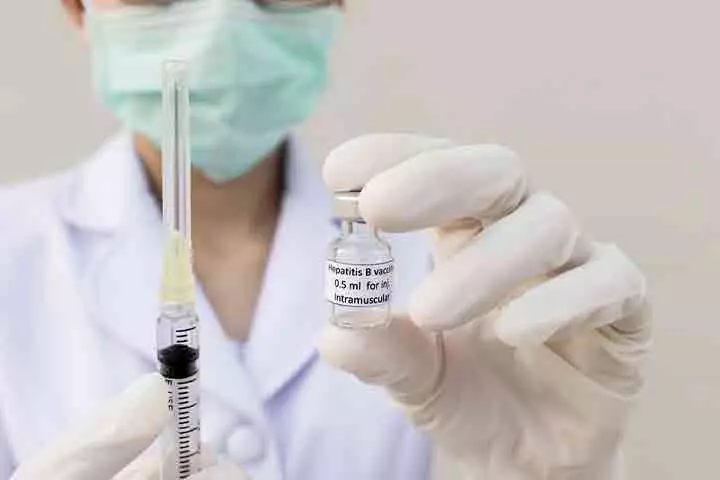
Image: iStock
Timely vaccination is essential to ensure babies develop sufficient immunity against potentially deadly diseases. Hence, it is important to know when specific vaccines should be administered; for example, some essential 2-month vaccines include polio and rotavirus vaccinations.

Vaccines are developed after extensive research on their safety and efficacy for widespread use (1). Though vaccines are of different types, most comprise an inactive or weak form of the pathogen or its toxin. They are called antigens and stimulate the immune system to produce antibodies, providing immunity (2).
Read this article to learn about the vaccines an infant should get in their second month, the possible side effects of the vaccines, and how to manage them.
Key Pointers
- According to CDC, two-month-old babies should be given HepB, DTap, PCV13, Hib, IPV, and RV vaccinations.
- Have your child hold their favorite toy, blanket, or pacifier, or breastfeed them during vaccination to keep them comfortable.
- Using a cool, damp cloth to reduce local irritation may help with redness and swelling at the injection site.
Vaccines Scheduled For A Two-month-old Baby
According to the Centers for Disease Control and Prevention (CDC), the following vaccines are given to babies at one to two months of age (3).
1. Hepatitis B (HepB) vaccine

- Hepatitis B is a contagious viral liver disease, which may cause extensive liver damage.
- The first dose of the HepB vaccine is given immediately after birth, the booster dose is given one or two months after birth, and the final dose is given anytime between six to 18 months.
- According to the CDC, the HepB vaccine is safe and effective against HepB infection.
- It may cause mild side effects such as a sore arm from the shot and low-grade fever (less than 101°F or 38.3°C) (4).
2. Diphtheria, tetanus, and pertussis (DTaP) vaccine

- Children are given five doses of DTaP.
- The first dose is given at the age of two months, followed by one booster dose each at four months, six months, 15 to 18 months, and four to six years of age.
- Mild side effects of DTaP are redness, pain, or swelling of the injection site, fever, and vomiting.
- Severe but rare complications of DTaP vaccines are high-grade fever (over 105°F or 40°C), inconsolable crying for three hours or more, and seizures (5).
The following are the symptoms and modes of transmission of diphtheria, tetanus, and pertussis.
- Diphtheria: Diptheria is a bacterial disease that can start with a sore throat, mild fever, and chills. It may also cause a coating in the back of the nose or the throat, making it difficult to breathe or swallow. The disease spreads through sneezing and coughing (6). It is important to note that the overall case-fatality rate for diphtheria is 5%–10%, with higher death rates (up to 20%) among persons younger than five and older than 40, as per a CDC report (7).
- Tetanus: Tetanus is caused by toxins produced by the tetanus bacteria found in soil, dust, and manure. The bacteria may enter the body through punctures, cuts, sores, burns, or animal bites. The toxins affect the muscles, causing stiffness and spasms. Severe cases may affect respiratory muscles, increasing the risk of respiratory muscles paralysis and death (8).
- Pertussis or whooping cough: Whooping cough is a respiratory infection caused by Bordetella pertussis that spreads through coughing and sneezing. The most notable sign of the illness is violent coughing with a whooping sound. Untreated cases may lead to severe pneumonia and respiratory failure in infants (9).
 Quick fact
Quick fact3. Pneumococcal vaccine (PCV13)

- Pneumococcal disease is caused by the pneumococcus bacteria that spread through coughing and sneezing.
- Pneumococcal disease affects the ears, lungs, blood, and brain.
- Common symptoms include high fever, cough, chest pain, and body pain.
- The disease may lead to severe complications, such as meningitis, if left untreated.
- The first dose of the vaccine is given at two months of age, followed by booster doses at the age of four months, six months, and between 12 and 15 months.
- Side effects of the PCV13 vaccine are usually very mild. These may include fussiness, lethargy, loss of appetite, local reactions at the injection site (redness, swelling, or pain), fever, chills, or headache (10).
4. Haemophilus influenzae type b (Hib) vaccine
- Hib disease is a severe illness caused by the bacteria Haemophilus influenzae type b (Hib) bacteria.
- The bacteria usually affects the nervous system, causing encephalitis and/or meningitis. The symptoms include high fever, headache, poor appetite, and vomiting.
- The first dose of the vaccine is given at two months, followed by booster doses at four months, six months, and between 12 and 15 months.
- Hib vaccine has very mild side effects such as fever and local reactions at the injection site, such as redness, swelling, or pain (11).
5. Polio (IPV) vaccine

- Polio or poliomyelitis is a disabling disease caused by the poliovirus.
- The virus can infect the spinal cord and nerves, causing irreversible paralysis and respiratory failure.
- It is a highly contagious disease that spreads through food and water contaminated with respiratory droplets or feces.
- The child gets one dose each at two months, four months, between six and 18 months, and between four and six years.
- Redness, swelling, and pain might occur at the injection site if the baby received the injectable variant of the vaccine (12). The oral polio vaccine, which is less commonly given, causes no side effects.
 Point to consider
Point to consider6. Rotavirus (RV) vaccine
- Rotavirus infection causes severe diarrhea and vomiting accompanied by fever, stomach pain, and loss of appetite. The infection primarily affects infants.
- Severe dehydration is the leading complication of the disease and a common cause of fatality.
- There are two types of rotavirus vaccines, RotaTeq (RV5) and Rotarix (RV1).
- RV5 is given in three dosages at ages two months, four months, and six months. RV1 is given in two dosages at ages two months and four months.
- Rotavirus vaccines are given in the form of oral drops and not injections.
- Mild side effects include fussiness, diarrhea, and vomiting.
- A rare complication is intussusception, a condition where a section of the intestine folds on the adjacent part. It is estimated to occur in one out of 20,000 to 100,000 vaccinated babies (13).
Preparing A Two-month-old For Vaccine Shots
The following steps could help you comfort your baby before, during, and after vaccination (14).
- Pack the baby’s favorite toy, pacifier, or blanket to make them feel cozy and comfortable.
- Check with the pediatrician if they can give a safe sweet-tasting solution to your baby right before the vaccination. This can help distract the baby from pain and reduce crying.
- If possible, breastfeed your baby during the vaccine administration to soothe and calm them down.
- You may check with the pediatrician if they can apply a pain-relieving ointment or spray before vaccine administration.
- You may distract the baby by singing their favorite songs or rhymes.
- You may also give them a pacifier to calm them down.

- You may swing and rock them in your arms immediately after vaccination. Another alternative is to distract them with something interesting.
- Cuddle them often after the vaccination. You may also breastfeed them immediately after vaccination to calm down the fussiness caused by the pain at the injection site.
Helping The Baby With Side Effects
Local reactions at the injection site, such as pain, redness, or swelling, are common and resolve within a day or two after vaccination in babies. Some babies may develop rashes and fever that usually last no more than a few days and do not pose any severe health risks.
The following tips will help you manage mild vaccine side effects at home (14).
- Ask the pediatrician about the side effects and abnormal effects.
- Use a cool, damp cloth to reduce local irritation, redness, swelling, or soreness.
- Use cool pads to reduce the fever.
- Ensure the baby gets adequate rest.
- Ask the healthcare provider if they can prescribe a baby-safe pain reliever, including pain-relieving topical ointments.
- Check with your doctor if you suspect or notice anything unusual.
Frequently Asked Questions
1. When should I be concerned after two-month shots?
Watch out for immunization reactions after your baby has received vaccinations. If your baby has a high fever (above 104° F (40° C)), has been fussy after the shots, or develops rashes or swelling, consult a doctor for prompt medical attention (15).
2. Do babies sleep a lot after two-month shots?
Sleep duration in infants could increase after vaccination. As per a study published in the US National Library of Medicine, infants who developed a fever after vaccination slept for long periods during the next 24 hours (16).
3. Should I give my two-month-old Tylenol after shots?
If your child has been intolerant to the pain of a shot, you may give them child-friendly Tylenol after the recommendation of a pediatrician. Also, make sure to ask the doctor the frequency and the dosage of Tylenol suitable for your baby (17).
Two-month vaccines are important for babies as they provide protection against life-threatening diseases. Some parents avoid getting their little ones vaccinated, worrying about the side effects, but they are negligible. You may also check with the pediatrician if the benefits outweigh the risks. Hence, do not think about avoiding the vaccines for their betterment. Always remember that it is safe for your baby to get vaccinated to avoid disease and its complications in the future. So, keep your baby’s vaccination schedule ready, set a reminder, and understand the tricks that can help if any side effects pop up.
Infographic: What Are The Scheduled Vaccines For A Two-Month-Old Baby
Vaccinations play an important role in protecting infants from preventable diseases. This infographic below explores the recommended immunization regimen for two-month-old babies. Numerous vaccination schedules begin as early as two months of age, and being aware of these schedules will help you stay updated and protect your babies from potentially fatal illnesses.
Some thing wrong with infographic shortcode. please verify shortcode syntaxHelp your baby feel better after their 2-month shots with these simple tips. Learn how to soothe their discomfort and provide comfort.
References
1. Reasons to Vaccinate; Centers for Disease Control and Prevention
2. How Vaccines Strengthen Your Baby’s Immune System; Centers for Disease Control and Prevention
3. Vaccines by Age; Centers for Disease Control and Prevention
4. Vaccine for Hepatitis B; Hepatitis B Foundation
5. Diphtheria, Tetanus, and Pertussis Vaccine Recommendations; Centers for Disease Control and Prevention
6. About Diphtheria; Centers for Disease Control and Prevention
7. Diphtheria; Centers for Disease Control and Prevention
8. Tetanus; Centers for Disease Control and Prevention
9. Pertussis; Centers for Disease Control and Prevention
10. Vaccine (Shot) for Pneumococcal Disease; Centers for Disease Control and Prevention
11. Hib Vaccination; Centers for Disease Control and Prevention
12. Polio Vaccination; Centers for Disease Control and Prevention
13. Rotavirus Vaccination; Centers for Disease Control and Prevention
14. Before, During, and After Shots; Centers for Disease Control and Prevention
15. Immunization Reactions; Seattle Children’s
16. Linda Franck et al; Infant Sleep After Immunization: Randomized Controlled Trial of Prophylactic Acetaminophen; US National Library of Medicine.
17. Acetaminophen (Tylenol etc.) Dosage Table; University Hospitals Rainbow Babies & Children’s.
Community Experiences
Join the conversation and become a part of our nurturing community! Share your stories, experiences, and insights to connect with fellow parents.
Read full bio of Dr. Jessica Madden
Read full bio of Dr. Ritika Shah
Read full bio of Rohit Garoo
Read full bio of Ghazia Shah


















